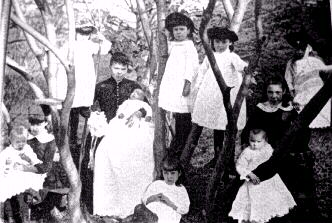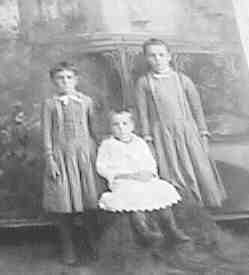
Figure 1.--Some mothers in the late 19th Century and early 20th Century liked to dress the entire family, with in those days could be quite large, in the same outfit.


Figure 1.--Some mothers in the late 19th Century and early 20th Century liked to dress the entire family, with in those days could be quite large, in the same outfit. |
One fashion popular with mothers was to dress brothers and sisters in identical or coordinated outfits. ome mothers took this one step further.
Some mothers chose to dress all of the children in the family identically, even children of different ages and genders. Some mothers in the late
19th and early 20th century had quite large families and all of the children in identical or similar outfits was quite a striking site.
This practice was most common in the late 19th century. Some mothers
would actually choose identical or similar outfits. More common was
some clothing differences based on gender or age, but having the children
wear pinafores and more commonly for boys--
smocks. This gave the entire family, both the boys and girls alike, a common look.
Some mother like to dress all of their children in the same style. I believe this was particularly popular in the late 19th Century and early 20th Century. This is primarily bcause more images exhibiting this style
are available from this period. This could, however simpily reflect the larger number of images available from ghis era because of the development of photography. Families in the 19th Century could be quite large, sometimes five to 10 children. In these larger families, some of the older children were permitted their own individual clothes, but the younger children were dressed alike.
Some individual images offer interesting insights into 19th Century families and the clothing chosen by mothers in that period. Unfortunately usually information on the families is not available, only the image is available.
Some individual images offer interesting insights into 19th Century families and the clothing chosen by mothers in that period. Unfortunately
usually information on the families is not available, only the image
is available.
Identical Outfits
Mothers with large families could usually not dress all the children identically because of age and gender differences. Some mothers did, however, decide to dress all, or most, of the children in smocks. This gave the desired unifiorm look although the clothes worn under the smocks could be quite different.
Another option in a large family was to dress the children of similar ages identically. Thus the younger and older children might be dressed differently. The tyounger boys might wear dresses or kilts while the older boys allowed to wear suits.
Mothers who liked to dressed their children identically found it much easier if they had a small family with children of similar ages.
Some mothers dresses their children alike, but there were minor differences in the outfit. The differences might be with the bow or collar worn with a dress or suit. It is not always apparent if these differences werevmade to designate age or gender differences or perhaps just carelessness in matching the outfits or finding, for example, identical collars in the same size. I have collected some images which I will attempt to evaluate to try
to determine some of the conventions for dressing children.
Some mothers while choosing identical or similar styles for the children allowed minor age destinctions of various types. This varies greatly from
familt to family. A mother keep all of her children in dresses, for example, might choose different dresses for the younger and older children. There might also be minor differences in the children's dresses.

Figure 2.--This mother outfitted the youngest boy in a white dress and the older two children, a boy and girl, in identical dresses. The photograph was probably taken in the early 1880s. |
One late 19th mother dressed her three children in dresses. They look to be two boys and a girl. The two older children are in an identical colored dress. The younger boy wears a white dress. The older girl
appears to have a small colored hair bow. Interestingly the boy on the left seems to have out grown his dress. (Note how high the sleeves are above the wrist.) That raises an interesting question. Presumably the dresses were bought at the same time, or the elder child's bought first. You might
think therefore that the elder child would outgrow the dress first.
The only difference in the dress that I can detect are the different
collar bows on the two older children. The
small size of the bows and the lack of large hair bows suggests to me that the photograph was taken in the late 1870s or early 1890s.
The decission to dress all of the children identically usually meant meant dresses, smocks,
or pinafores.
The outfits chosen by 19th and early 20th Century mothers to dress
their family identically was dresses. It was quite acceptable to outfit
little boys in dresses during the 19th Century. It was not acceptable,
however, to dress girls at the time in trousers, keepants, or knickers.
Some mothers decided on identical smocks rather than the same outfits for their children. Both white and darl colored smocks were chosen. French mother sometime chose brightly colored smocks.
The images I have of children in pinafores are individual children. I do not yet have family group photographs of the children in pinafores.
This of course does not mean that some mothers did not
choose pinafores for her children. I think that the expensive, studio photography of the day meant that the children were dressed upmin their
best party suits rather than pinafores.
Navigate the Boys' Historical Clothing Web Site:
[Return to the Main family style page]
[Introduction]
[Chronolo gy]
[Clothing styles]
[Biographies]
[Bibliographies]
[Activities]
[Countries]
[FAQs]
[Fashion messages]
[Contributions]
[Boys' Clothing Home]
